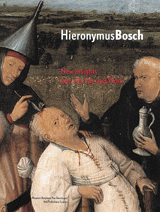
Van Schoute et al. 2001
“Bosch and his Sphere. Technique” (Roger Van Schoute, Hélène Verougstraete and Carmen Garrido) 2001
[in: Jos Koldeweij, Bernard Vermet and Barbera van Kooij (eds.), Hieronymus Bosch. New Insights Into His Life and Work. Museum Boijmans Van Beuningen-NAi Publishers-Ludion, Rotterdam, 2001, pp. 102-119]
This contribution can be seen as a summary of the results of the technical research to which the authors have subjected the works of Bosch and his followers for some decades. Recent findings of other researchers in the same field have been added to this. The Adoration of the Magi triptych and the Haywain triptych (both in the Prado) still have at least a part of their original frames. The joinery of the Prado Adoration frames can have been done in Brussels around 1500. These frames may have been delivered to Bosch by the patron who commissioned the painting. Only the wings of the Prado Haywain still have their original frames. The Escorial Haywain still has its original frames and these frames are of a kind not found in the Netherlands before the 1520s.
The examination of the underdrawing in a number of works attributed to Bosch (in 1967 and 2001) resulted in the distinguishing of three types of underdrawing, which could, however, be the work of one and the same person: there is no reason to assume that an artist would only use one type of underdrawing during his career. Examination of the pictorial layers in the works of Bosch have led to the following paraphrase of the artist’s style of painting: ‘Bosch often works with clear impasto that catches the light. Sometimes he makes more lavish use of a thick paste which he models vigorously by crushing the brush into it, thus forming a hollow line between protuberant strips, or by using the wood of the brush; he is not concerned about making the surfaces homogeneous. Each touch is separate; the eye re-creates surfaces and volumes from a distance’ [p. 109]. Next the authors focus on the alterations that were applied to a number of Bosch’s works (at the underdrawing, during the painting stage or later). This part of the text mainly deals with the overpainted figures of donors.
In the second part of this contribution the authors report a number of their findings regarding the works of Bosch’s followers. The distinction between originals and copies is often difficult and delicate and in the past some authors have already stressed the fact that in this field technical research of the paintings can be very useful. The comparison of three Adoration of the Magi triptychs by Bosch followers (Banbury, Anderlecht and Vught) leads to the conclusion that these three works do not derive from each other, although they have a number of details in common which differ from Bosch’s Adoration of the Magi (Prado). Elements derived from the original were mingled with ideas that have nothing to do with Bosch. According to the authors this example shows how Bosch followers dealt with original compositions of Bosch and they conclude that we should not speak too fast of ‘copies from a lost original’.
The three copies of the central panel of the Garden of Delights (Budapest, Nuremberg, Brussels) were made on a scale of 1:1. The so-called Pomereu copy (currently in Brussels) must have been made after the original or after a very faithful copy and must be dated later than 1550 (according to dendrochronological research). Perhaps this copy was commissioned by Philip II. The Prado Haywain shows all the characteristics of an original. As mentioned before, the original frame of the Escorial Haywain shows that this triptych can be dated after 1520. The Brussels copy of the Temptations of St. Anthony triptych (Lisbon), the only copy to reproduce the whole original work, is very faithful and of excellent quality. The underdrawing shows genuine mastery.
The Crowning with Thorns in the Prado is known in two other versions: one in the Museo Lazaro Galdiano (Madrid) and one in Valencia (where it is part of a triptych). Because of the applied technique the authors are of the opinion that none of these three works is based on a Bosch original. Relying on computer-assisted simulation they believe that the composition of these three works has been derived from the London Crowning with Thorns (which is a Bosch original). The example of these three Crowning with Thorns versions shows that after Bosch’s death new prototypes could be created, deriving their inspiration only distantly from Bosch himself. Apparently some Bosch followers copied the originals in a faithful way, whereas others adapted Bosch’s themes according to their own views. Once again the authors warn of speaking too hastily of ‘lost originals’, when dealing with works painted by Bosch followers.
Although they don’t mention him explicitly, the authors seem to be referring to the findings of Paul Vandenbroeck with this last remark (see e.g. Vandenbroeck 2001a).
[explicit]